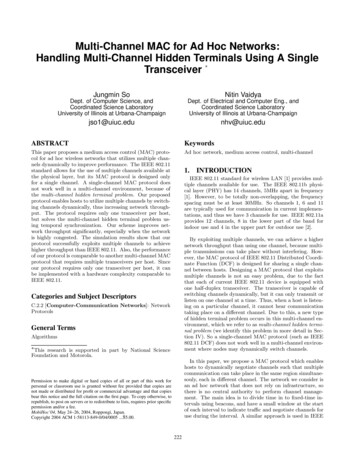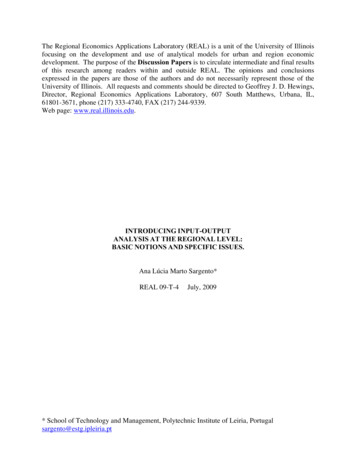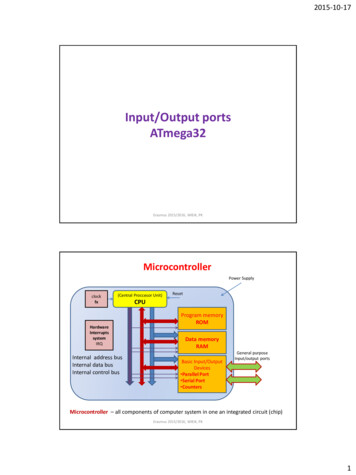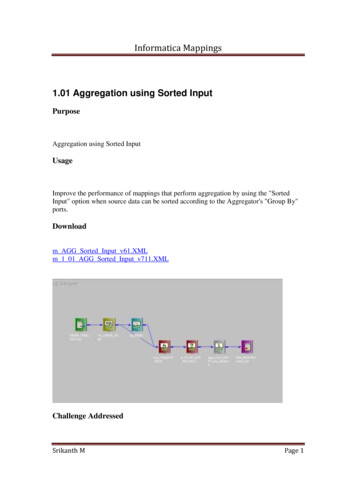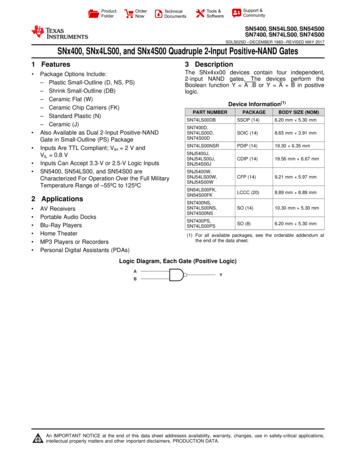
Transcription
Full-Hiding (Unbounded) Multi-Input Inner Product FunctionalEncryption from the 𝒌-Linear AssumptionPratish Datta, Tatsuaki Okamoto, and Junichi TomidaNTT Secure Platform LaboratoriesTokyo, 180-8585 chi @lab.ntt.co.jpFebruary 13, 2018𝐀𝐛𝐬𝐭𝐫𝐚𝐜𝐭. This paper presents two non-generic and practically efficient private key multi-inputfunctional encryption (MIFE) schemes for the multi-input version of the inner product functionalitythat are the first to achieve simultaneous message and function privacy, namely, the full-hidingsecurity for a non-trivial multi-input functionality under well-studied cryptographic assumptions.Our MIFE schemes are built in bilinear groups of prime order, and their security is based on thestandard 𝑘-Linear (𝑘-LIN) assumption (along with the existence of semantically secure symmetrickey encryption and pseudorandom functions). Our constructions support polynomial number ofencryption slots (inputs) without incurring any super-polynomial loss in the security reduction.While the number of encryption slots in our first scheme is apriori bounded, our second scheme canwithstand an arbitrary number of encryption slots. Prior to our work, there was no known MIFEscheme for a non-trivial functionality, even without function privacy, that can support an unboundednumber of encryption slots without relying on any heavy-duty building block or little-understoodcryptographic assumption.𝐊𝐞𝐲𝐰𝐨𝐫𝐝𝐬: multi-input functional encryption, inner products, full-hiding security, unbounded arity, bilinear maps1IntroductionFunctional encryption (FE) [BSW11,O’N10] is a new vision of modern cryptography that aims to overcomethe potential limitation of the traditional encryption schemes, namely, the so called “all-or-nothing”control over decryption capabilities, i.e., parties holding the legitimate decryption key can recover theentire message encrypted within a ciphertext, whereas others can learn nothing. Specifically, FE offersadditional flexibility by supporting restricted decryption keys which enable decrypters to learn specificfunctions of encrypted messages, without revealing any additional information. More precisely, an FEscheme for a function family ℱ involves a setup authority which holds a master secret key and publishespublic system parameters. An encrypter uses the public parameters (along with a secret encryption keyprovided by the setup authority in case of a private key scheme) to encrypt its message 𝑚 belonging tosome supported message space ℳ, creating a ciphertext ct. A decrypter may obtain a private decryptionkey sk corresponding to some function 𝑓 ℱ from the setup authority provided the authority deemsthat the decrypter is entitled for that key. Such a decryption key sk corresponding to certain decryptionfunction 𝑓 can be used to decrypt a ciphertext ct encrypting some message 𝑚 to recover 𝑓 (𝑚). Thebasic security requirement for an FE scheme is the privacy of encrypted messages against collusion ofdecrypters, i.e., an arbitrary number of decrypters cannot jointly retrieve any more information about anencrypted message beyond the union of what they each can learn individually.Multi-input functional encryption (MIFE), introduced by Goldwasser et al. [GGG 14], is a generalization of FE to the setting of multi-input functions. An MIFE scheme has several encryption slots,and messages can be encrypted to different slots independently. A MIFE decryption key for an 𝑛-inputfunction 𝑓 simultaneously decrypts a set of 𝑛 ciphertexts, each of which is encrypted with respect to oneof the 𝑛 input slots associated with 𝑓 , to unveil the joint evaluation of 𝑓 on the 𝑛 messages encryptedwithin those 𝑛 ciphertexts. Just like single-input FE the primary security requirement for an MIFE schemeas well is the privacy of encrypted messages against collusion attacks. However, unlike single-input FE,the formalization of this security notion in case of MIFE is somewhat subtle. In their pioneering work,*This is the full version of an extended abstract that will appear in the proceedings of PKC 2018.
Goldwasser et al. [GGG 14] presented a rigorous framework to formally capture message privacy forMIFE, both in the public key and in the private key regimes.MIFE is particularly useful in scenarios where informations, which need to be processed together duringdecryption, become available at different points of time or are supplied by different parties. In fact, MIFEcan be employed in a wide range of applications pertaining to computation and mining over encrypteddata coming from multiple sources. Examples include executing search queries over encrypted databases, processing encrypted streaming data, non-interactive differentially private data releases, multiclient delegation of computations to external servers, and many more. All of these applications are in factrelevant in both the public key and the private key regimes.In view of its countless practical applications, a series of recent works have attempted to construct MIFE schemes based on various cryptographic tools. These constructions can be broadly classifiedinto two categories. The first line of research has tried to build MIFE schemes for general multi-inputfunctionalities, e.g., arbitrary polynomial-size circuits [GGG 14, AJ15, BKS16, GJO16, KS17] or Turingmachines [BGJS15]. Unfortunately however, all such MIFE constructions rely on highly strong cryptographic primitives like indistinguishability obfuscation [BGI 01, GGH 16], single-input FE for generalcircuits [GGH 16, GGHZ16], or multilinear maps [GGH13, CLT13], neither of which is currently instantiable using efficient building blocks or under well-studied cryptographic assumptions. Consequently, asecond line of research have emerged whose focus is to design concretely efficient MIFE schemes based onstandard assumptions for specific multi-input functionalities, e.g., comparison [CLWW16,LW16,CLOZ16]or multi-input inner product [KLM 16,LL16,AGRW17]. However, majority of the existing works on MIFEhave concentrated merely on achieving the basic security notion, namely, message confidentiality.Unfortunately, message confidentiality is not sufficient in several advanced applications of FE, ratherprivacy also needs to be ensured for the functions for which the decryption keys are issued. This is especially important in situations where the decryption functions themselves contain sensitive informations.Consider the following scenario: Suppose a hospital subscribes to an external cloud server for storingmedical records of its patients. In order to ensure confidentiality of the records and, at the same time,remotely perform various computations on the outsourced data from time to time, a promising choicefor the hospital is to use an FE scheme to encrypt the records locally prior to uploading to the cloudserver. Now, suppose the hospital wishes to retrieve the list of all patients who is receiving treatment fora certain chronic disease from the cloud server. For this, the hospital needs to provide the cloud servera decryption key for the corresponding functionality. However, if the FE scheme used by the hospitalpossesses no function privacy, then the cloud server would get to know the functionality from the decryption key provided by the hospital. Thus, after performing the assigned computation, if the cloud servernotices the name of some celebrity in the obtained list of patients, it would at once understand that theparticular celebrity is suffering from such a chronic disease, and it may leak the information to the mediapossibly for financial gain. This is clearly undesirable from the privacy point of view.In order to address such scenarios, several recent works have studied the notion of function privacyin the context of FE, both in the single-input setting [SSW09, AAB 13, BS15, ITZ15, BRS13a, BRS13b,BJK15,DDM16,TAO16,KLM 16,LV16,Lin17] and in the multi-input setting [BKS16,AJ15,KS17,Lin17].Intuitively, function privacy demands that the decryption keys leak no additional information about thefunctions embedded within them, beyond what is revealed through decryption. However, it has been observed that the extent to which function privacy can be realized differs dramatically between the publickey and the private key regimes. In fact, in the public key setting, where anyone can encrypt messages, onlya weak form of function privacy can be realized [BRS13a,BRS13b,ITZ15]. More precisely, in order to capture function privacy for FE in the public key setting, the framework must assume that the functions comefrom a certain high-entropy distribution. On the contrary, function-private FE (both the single-input andthe multi-input versions) has been shown to possess great potentials in the private key setting, not only asa stand-alone feature, but also as a very useful building block [ABSV15,AJ15,KSY15,LV16,Lin17,KS17].Consequently, the research on function-private FE has been focused primarily on the private key setting. However, despite of its immense theoretical and practical significance, so far, there are only ahandful of function-private FE schemes available in the literature that can be implemented in practice [BJK15, DDM16, TAO16, KLM 16, LV16, Lin17], and all of them have been designed for single-inputfunctions, precisely, inner products. In case of function-private MIFE, the only known concrete construction is the recent one due to Lin [Lin17]. She has constructed a private key function-private MIFE schemefor computing inner products of arbitrary polynomial degree, where standard inner product is a degree2 function. However, her construction employs multilinear maps, and thus is currently uninstantiable inpractice.2
In this work, our goal is to design practical private key function-private MIFE scheme supporting a polynomial number of encryption slots, incurring only polynomial loss in the security reduction. Goldwasser et al. [GGG 14] have already shown that private key MIFE for general functionalities supporting a polynomial number of encryption slots is equivalent to full-fledged indistinguishabilityobfuscation. Hence, it seems impossible to design such highly expressive MIFE scheme without a subexponential security loss [GGSW13]. In fact, all existing private key MIFE schemes for general functionalities [GGG 14, BKS16, AJ15, KS17] do suffer from at least a quasi-polynomial security loss to supporteven a poly-logarithmic number of encryption slots. Hence, we concentrate on a specific multi-input functionality that has a wide range of real-life applications, namely, the natural multi-input generalization ofthe inner product functionality. This functionality has been first considered by Abdalla et al. [AGRW17].Concretely, a multi-input inner product function 𝑓{ #»𝑦 𝜄 }𝜄 𝑆 is associated with a set 𝑆 of encryption slotindices and vectors #»𝑦 𝜄 ℤ𝑚 for all 𝜄 𝑆. It takes ︀as input a set of vectors { #»𝑥 𝜄 }𝜄 𝑆 with the same index#»set 𝑆, where #»𝑥 𝜄 ℤ𝑚 for all 𝜄 𝑆, and outputs𝑥 𝜄 · #»𝑦 𝜄 , where #»𝑥 𝜄 · #»𝑦 𝜄 represents the inner product𝜄 𝑆of the vectors #»𝑥 and #»𝑦 over ℤ. It is required that the norm of each component inner product #»𝑥 · #»𝑦 is𝜄𝜄𝜄𝜄smaller than some upper bound B. Observe that this functionality is different from the high-degree innerproduct functionality considered by Lin [Lin17]. The multi-input inner product functionality capturesvarious important computations arising in the context of data-mining, e.g., computing weighted mean ofinformations supplied by different parties. Please refer to [AGRW17] for a comprehensive exposure of thepractical significance of the multi-input inner product functionality.Abdalla et al. [AGRW17] have presented an MIFE scheme for the multi-input inner product functionality described above in the private key setting, using bilinear groups of prime order. Their constructionsupports a fixed polynomial number of encryption slots and multi-input inner product functions associated with a fixed index set 𝑆 of polynomial size, as well as incurs only a polynomial loss in the securityreduction. Precisely, the index set 𝑆 in their construction is of the form 𝑆 [𝑛] {1, . . . , 𝑛}, where 𝑛is the number of encryption slots – a polynomial determined at the time of setup, for the multi-inputinner product functions. Their construction achieves adaptive message privacy against arbitrary collusion, as per the framework of Goldwasser et al. [GGG 14], in the standard model under the well-studied𝑘-Linear (𝑘-LIN) assumption [Sha07]. Prior to the work of Abdalla et al. [AGRW17], two independentworks, namely, [KLM 16,LL16] were able to realize a two-input variant of their result, of which [KLM 16]achieved it in the generic group model. However, none of these constructions guarantee function privacy.In fact, in their paper [AGRW17], Abdalla et al. have posed the construction of a function-private MIFEscheme for the multi-input inner product functionality based on the 𝑘-LIN assumption in prime orderbilinear groups as an open problem.𝐎𝐮𝐫 ��In this paper we solve the above open problem. More specifically, we construct two concretely efficientstandard-model private key MIFE schemes for the multi-input inner product functionality in prime orderbilinear groups that are the first to achieve function privacy under well-studied cryptographic assumptions. In fact, our constructions achieve the unified notion of message and function privacy, namely,the full-hiding security, formulated by Brakerski et al. [BKS16] in the context of private key MIFE bycombining the corresponding notion in the context of private key single-input FE [AAB 13, BS15] withthe framework for message privacy of MIFE [GGG 14], under the 𝑘-LIN assumption (along with theexistence of semantically secure symmetric key encryption and pseudorandom functions). Both of ourconstructions support polynomial number of encryption slots and are free from any super-polynomialloss in the securi
notices the name of some celebrity in the obtained list of patients, it would at once understand that the particular celebrity is suffering from such a chronic disease, and it may leak the information to the media possibly for financial gain. This is clearly undesirable from the privacy point of view. In order to address such scenarios, several recent works have studied the notion of function .

